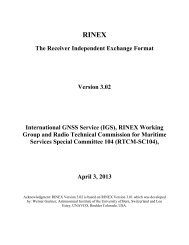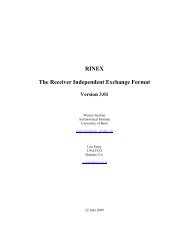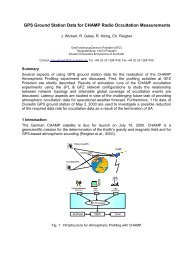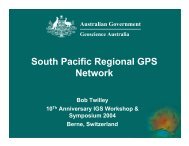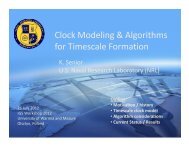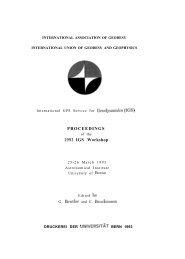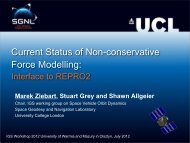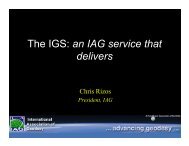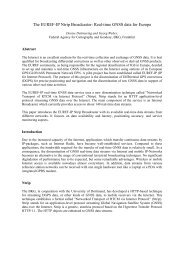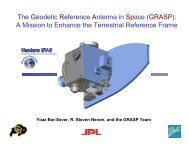IGS Analysis Center Workshop - IGS - NASA
IGS Analysis Center Workshop - IGS - NASA
IGS Analysis Center Workshop - IGS - NASA
You also want an ePaper? Increase the reach of your titles
YUMPU automatically turns print PDFs into web optimized ePapers that Google loves.
operation. Likewise, Japanese government agencies are establishing a permanent, 60station crustal deformation monitoring network in the Kanto plain and an active controlnetwork of over 100 stations across the entire Japanese archipelago. At the presenttime, the analysis centers use about 20 to 40 stations in their routine solutions. Dataprocessing time is at best proportional to the square of the number of observingstations, so a 90 station network takes an order of magnitude more time to process thana 30 station network, Computer memory limitations present a similar problem.Fortunately, there is little reason to process a 90 station network simultaneously.There are a number of strategies that can reduce processing time by an order ofmagnitude without compromising regional positioning accuracy.(b) Increased involvement %At present, there are seven analysis centers producing globalsolutions, with little need for more. As the number of stations increases around theworld, new analysis centers can make a considerable contribution by focusing theirattention on regional clusters, which they can monitor efficiently for problems. Singleproblematic stations might go unnoticed or ignored by those groups who are primarilyinterested in global parameters. A regional analysis center will have more of a vestedinterest in the performance of the regional cluster. It will also help ensure that the“polyhedron” does not remain that of -40 core sites used in the global processing, butthat it include data consistently from, perhaps, hundreds of new permanent sites. Theregional analysis center can also serve a dual function in providing assistance to usersperforming GPS surveys, and validating the resulting products. Needless to say, moreinvolvement will also lead to a broader base of expertise and knowledge from which<strong>IGS</strong> can draw the best ideas and solutions to problems.(C) Standardization and conslstencv . The recent trend to more stations is accelerating, withno reason to believe that it will slow down. The analysis of GPS data iscomputationally intensive so that it is not practical to reprocess all available data manytimes as is done with VLBI data, for example. Recognizing this, it is imperative thatthe routine data reduction of tomorrow’s blossoming regional networks be done in amutually consistent, acceptable, and archivable way. Without adequate preparation andorganization, we may effectively lose a golden opportunity for unifying the world’sGPS networks. It is assumed that there is no problem finding willing analysis centers(regional networks are not installed without some plan for analysis!). <strong>IGS</strong> can facilitatea consensus on a set of standards so that a required level of consistency and efficiencyis realized. Given the benefits that regional network users will get in return (consistentreference frame, consistent orbits, expert information, etc.), it is likely that regionalanalysis groups will cooperate and abide by a reasonable set of standards.(d) ~nhancinz the “Service” in <strong>IGS</strong>. Until now, <strong>IGS</strong> global analysis centers have beenpreoccupied with the technical details and practical aspects that are necessary to deliverthe products. There now needs to be more focus on servicing our customers (ofcourse, we the participants are customers too). The current status is that customershave little guidance on using the routine <strong>IGS</strong> global products for regional networkgeodesy, and there is no formal way to feedback, the regional solutions into the globalreference frame. Any customers who want to get the highest levels of precision fortheir regional networks ought to be given explicit recommendations on how to proceed,and <strong>IGS</strong> should provide the means to make the procedure as simple as possible withoutsignific~tly compromising regional accuracy. <strong>IGS</strong> should also specify the proceduresby which the regional centers may submit their network solutions back to <strong>IGS</strong> (asemphasized above in point 1.2(c)).(e) )lef n“nz the Role of IG& At some point, increasing the number of stations in theglo~dl network will produce negligible improvement in the accuracy of estimated orbits63




